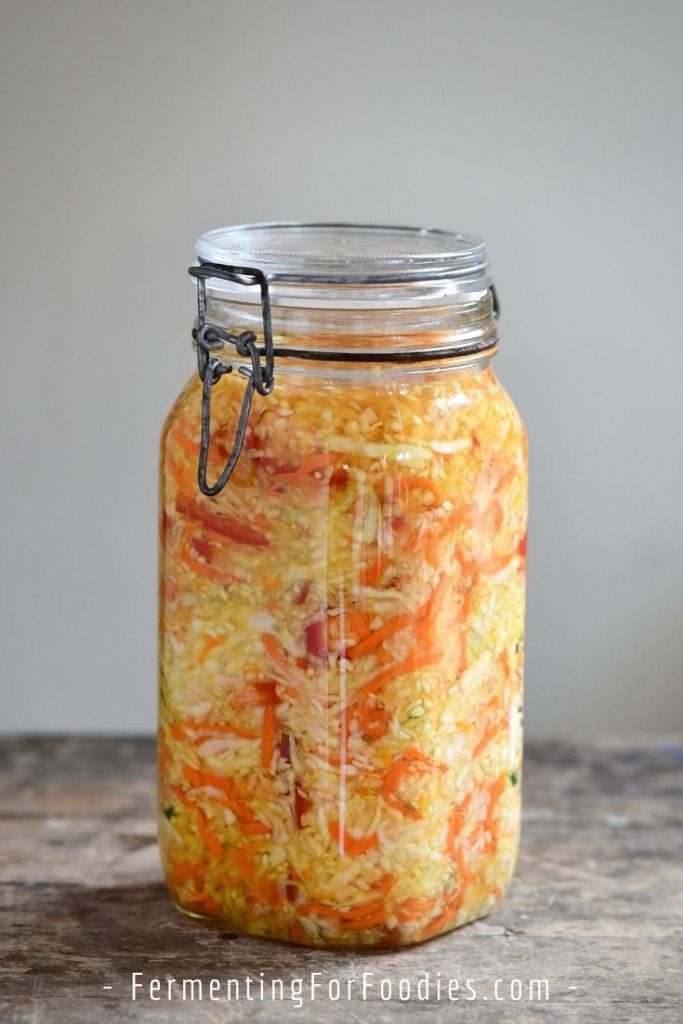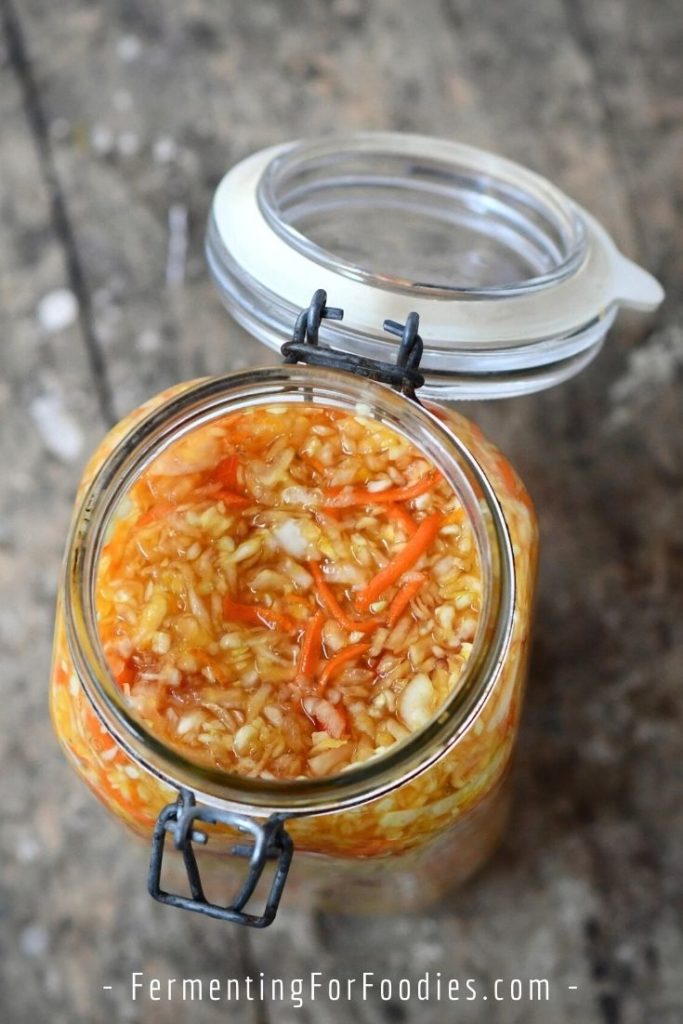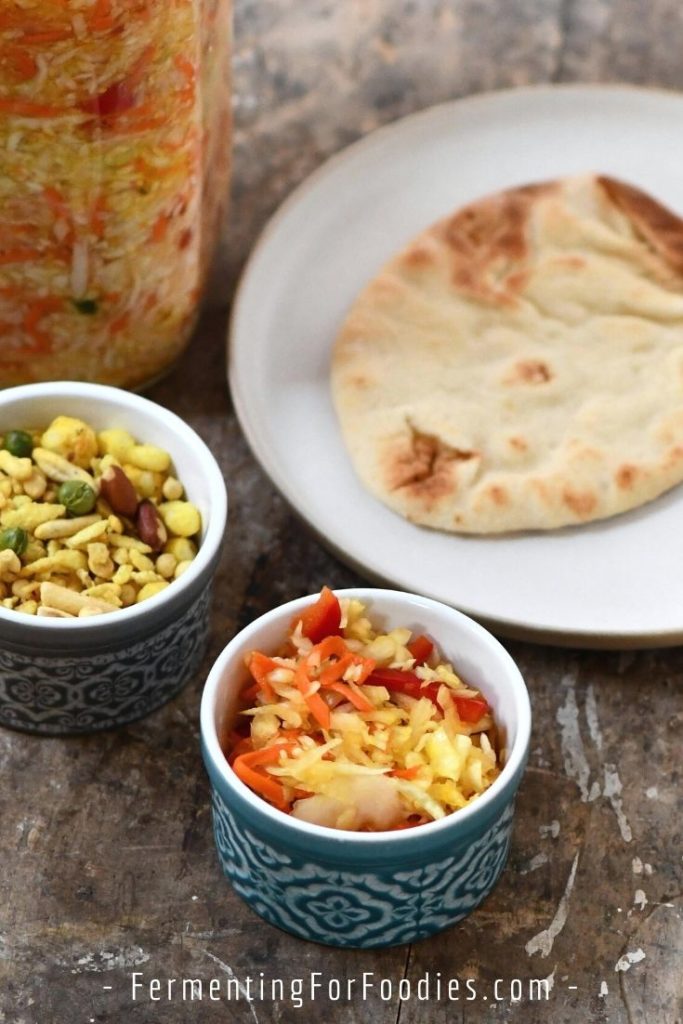Looking for a unique and delicious sauerkraut? This turmeric sauerkraut is made with mixed vegetables and spices. It is a flavorful and healthy condiment, packed full of probiotics and antioxidants.

Fermenting cabbage is so easy and reliable. It’s the perfect option for anyone new to fermenting. Or anyone who struggles with fermenting (usually due to issues with indoor air quality).
This spiced turmeric sauerkraut is a fun and flavorful variation.
Why ferment turmeric?
Adding turmeric not only gives this sauerkraut a bright yellow hue and distinct flavor but it’s also packed full of nutrients.
Turmeric is packed full of antioxidants. It’s naturally anti-inflammatory. And has all sorts of health benefits including improved liver functioning. That’s why there are so many fermented turmeric pills available in your local health food store.
However, it’s just as easy to add a bit of turmeric to your favorite ferment and make your own fermented turmeric!

Serving Options Turmeric Sauerkraut
The spices in this sauerkraut make it a very versatile condiment. It has a slightly spiced flavor that pairs nicely with all sorts of different meals.
Here are a few ways to serve turmeric sauerkraut:
- Trendy hot dog or hamburger topping
- Served on top of an Indian spiced curry
- As a delicious dosa filling
- Filling for Ethiopian injera flatbread
- A bright addition to a cheeseboard
- An immune-boosting side dish for winter meals
- As an alternative to salsa on tacos and pupusas

Spiced Turmeric Sauerkraut
This mixed vegetable sauerkraut is lightly spiced for a unique and flavourful variation on a traditional sauerkraut. It is packed full of probiotics and antioxidants for a healthy and delicious condiment. See the section above for some inspiring ways to serve turmeric sauerkraut.
- Prep Time: 20 minutes
- Total Time: 20 minutes
- Yield: 1.5 quarts (1.5 L) 1x
- Category: Condiment
- Method: Fermented
- Cuisine: Indian
- Diet: Vegan
Ingredients
- 1 small cabbage (or 1/2 cabbage), grated (about 2 lbs)
- 2 medium-sized carrots, grated
- 1 medium-sized onion, finely chopped
- 1 red pepper, cut into thin strips
- 1 green chili, finely chopped (optional)
- 1 1/2 Tbsp salt (non-iodized)
- 1-inch of fresh turmeric root (or 1 Tbsp powdered turmeric)
- 1 tsp mustard seed
- 1/2 tsp cumin seed
Instructions
- Prepare all the vegetables. Mix them with the salt in a large bowl.
- If you can find fresh turmeric, rinse the skin, however, don’t peel it. Using a fine grater, grate it into the bowl. Add the rest of the spices and toss to combine.
- Pack the sauerkraut into one or two glass jars for fermentation. It should make about 1.5 to 2 quarts. Pack the vegetables down in the jar with a wooden spoon so that they are well pressed into the jar, with no air bubbles.
- The salt should draw enough liquid out of the vegetables that they will be submerged, however, add up to 2 tablespoons of filtered water, if needed. Leave at least 1-inch (2.5 cm) of headroom at the top of the jar for bubbling. Cap with a lid that will allow gas to escape. Either a loose-fitting lid or a fermentation-specific lid will work.
- Ferment in a cool location for 3-5 days. See notes if you want to ferment for longer than 5 days.
- Store in the fridge and use up within 1 month.
Notes
- If you want to ferment it longer than 1-week, I recommend omitting the peppers (hot and sweet) as they go slimy with longer fermentation periods.
- Powdered turmeric is often treated with preservatives to keep it bright yellow. Try to find a natural, preservative-free brand for all your ferments.



I’m having a shot at this recipe today, with a few little tweaks. I live in Bali, so fresh ginger, turmeric, lemongrass and chilli are all abundant and included in my version, and I greater up some radish as well. Also added a little brine from a kimchi batch to get everything bubbling along. The colors are beautiful.
I have also got a batch of chili’s, garlic, lemongrass and ginger brewing to blend up as a hot sauce.
Really finding your site extremely useful and inspiring.
Sounds yummy!
Hi Emillie,
I made this recipe last night and I am wondering if it is meant to be tablespoons not teaspoons for the amount of salt because one and a half teaspoons of salt seems way too little. ( I decided it was meant to be tablespoons and added that much salt)
Hum… checking and updating this recipe is on my to-do list (quite literally for this weekend)! Thanks for flagging the salt. Probably 1 Tbsp is the right amount for a typical ferment. All my older posts were written when this blog was mostly what I did with my spare time, so they’re a bit more experimental and shot with a low-quality camera. 🙂 Now I test everything at least 3 times. And I’m in the process of redoing all the old posts right now.
Let me know if it ends up too salty, or just right. I would love to have that feedback. Cheers!
So having double-checked the recipe this past weekend, you are entirely right. Thanks for pointing out that typo!
Do you massage the cabbage/veggies to get the juices to come out before packing in jars? I was wondering about this for your piccalilli recipe as well.
No, I never bother with that. I find the veg usually releases enough liquid by the time I pack them in the jar. Just toss them in the salt, then they’ll naturally sweat.
This is really good!